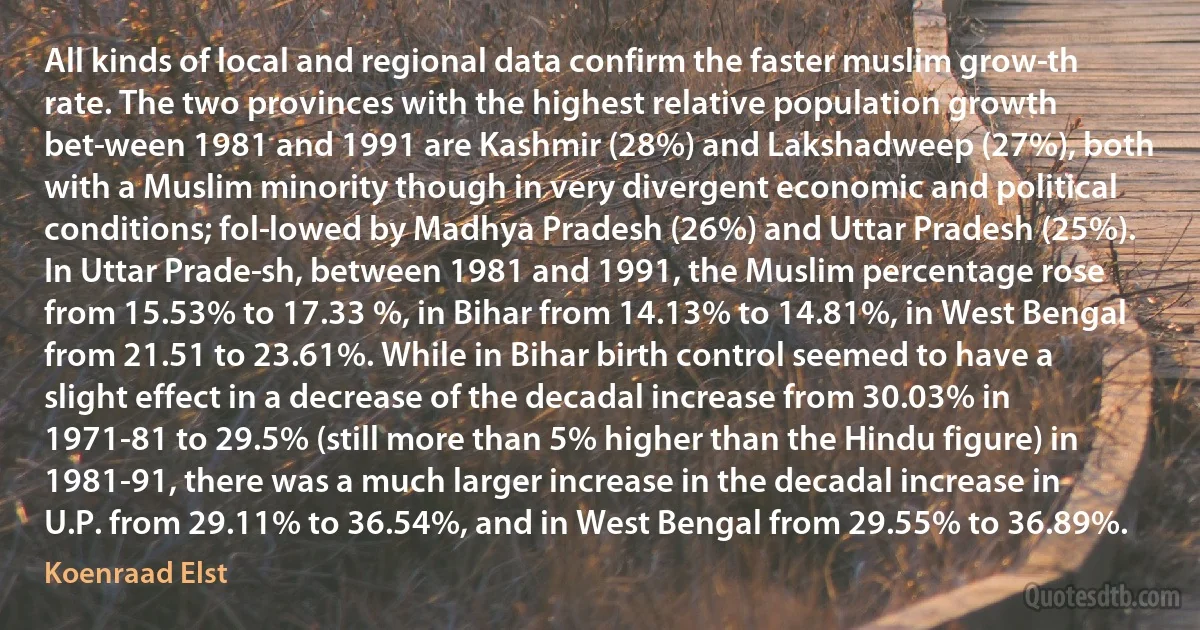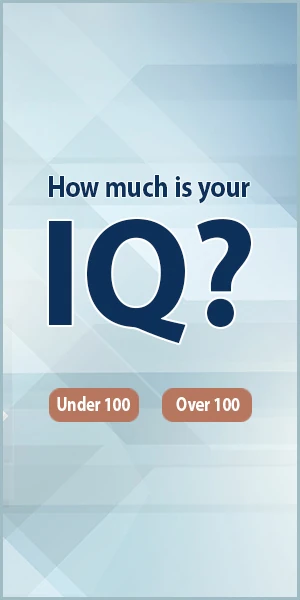
All kinds of local and regional data confirm the faster muslim growth rate. The two provinces with the highest relative population growth between 1981 and 1991 are Kashmir (28%) and Lakshadweep (27%), both with a Muslim minority though in very divergent economic and political conditions; followed by Madhya Pradesh (26%) and Uttar Pradesh (25%). In Uttar Pradesh, between 1981 and 1991, the Muslim percentage rose from 15.53% to 17.33 %, in Bihar from 14.13% to 14.81%, in West Bengal from 21.51 to 23.61%. While in Bihar birth control seemed to have a slight effect in a decrease of the decadal increase from 30.03% in 1971-81 to 29.5% (still more than 5% higher than the Hindu figure) in 1981-91, there was a much larger increase in the decadal increase in U.P. from 29.11% to 36.54%, and in West Bengal from 29.55% to 36.89%.
Koenraad ElstRelated topics
bengal birth control datum hindu increase percentage regional rose west while Bihar higher PradeshRelated quotes
...the principle of nationality and the principle of reverence for antiquity-the principle of what I may call local patriotism-is not only an ennobling thing in itself, but has a great economic value. ... The attachment to your country, the attachment among British subjects to Britain, but also the attachment among Welsh-born people to Wales, has in it, in some degrees, the nature both of an appeal to energy and an incentive to its development, and likewise, no few elements of a moral standard; for the Welshman, go where he may, will be unwilling to disgrace the name. It is a matter of familiar observation that even in the extremest east of Europe, wherever free institutions have supplanted a state of despotic government, the invariable effect has been to administer an enormous stimulus to the industrious activity of the country.

William Ewart Gladstone
Data management housekeeping is not the only problem to plague oversimplified approaches to high speed computation. The physical problems which are of practical interest tend to have rather significant complications. Examples of these complications are as follows: boundaries are likely to be irregular; interiors are likely to be inhomogeneous; computations required may be dependent on the states of the variables at each point; propagation rates of different physical effects may be quite different; the rate of convergence, or convergence at all, may be strongly dependent on sweeping through the array along different axes on succeeding passes; etc. The effect of each of these complications is very severe on any computer organization based on geometrically related processors in a paralleled processing system.

Gene Amdahl
The growth in money and credit has outpaced both savings and economic growth. These inflationary pressures have been concentrated in asset prices, not consumer price inflation--keeping monetary policy too easy. This increase in asset prices has fueled domestic borrowing and spending. Government policy and the increase in securitization are largely responsible for this bubble. In addition to loose monetary policies by the Federal Reserve, government-sponsored enterprises Fannie Mae and Freddie Mac have contributed to the problem. The fourfold increases in their balance sheets from 1997 to 1998 boosted new home borrowings to more than $1.5 trillion in 1998, two-thirds of which were refinances which put an extra $15,000 in the pockets of consumers on average--and reduce risk for individual institutions while increasing risk for the system as a whole.

Ron Paul
Bukharin, like Lenin, regarded the system of basing economic life on mass terror not as a transient necessity but as a permanent principle of socialist organization. He did not shrink from justifying all means of coercion and held, like Trotsky at the same period, that the new system called essentially for the militarization of labour – i.e. the use of police and military force to compel the whole population to work in such places and conditions as the state might arbitrarily decree. Indeed, once the market is abolished there is no longer any free sale of labour or competition between workers, and police coercion is therefore the only means of allocating "human resources”. If hired labour is eliminated, only compulsory labour remains. In other words, socialism – as conceived by both Trotsky and Bukharin at this time – is a permanent, nation-wide labour camp. (pg. 28-9)

Leszek Kołakowski
The economic betterment of a nation which is at a low level of intelligence and culture, or in which the population is small in relation to the extent and productivity of its territory, is best accomplished through free trade with highly cultivated, rich, and industrious nations. In the case of such a country every restriction of trade, intended to plant manufacturing industry within its borders, is premature and injurious, not only to the welfare of mankind in general, but to the progress of the nation itself. Only when the intellectual, political, and economic education of the nation has so far advanced as a result of free trade that its further progress would be checked and hindered by the import of foreign manufactures and the lack of a sufficient market for its own goods, can protective measures be justified.

Friedrich List
